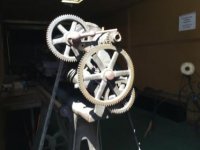MoriMillMan
Aluminum
- Joined
- Jan 6, 2019
Hello everyone, this is my first post. I recently saved 2 Barnes 4 1/2 lathes from my father. (He bought them because the legs were pretty) I am new to lathes, but I’ve read “How to Run a Lathe” and have taken apart cleaned and put back to togeather most of a Barnes. Anyways... first question I wonder what the max spindle speed for this lathe should be? I’d hate to push it harder than it was originally intended to be. And second question I just finished putting the lead screws and carriage on the bed. When I tried to adjust the gib for the x axis there was no way to travel the full bed length without having BAD slop in the carriage. Is there something I can do to alleviate this? Or should I clean up the other bed and see if it works better? Or maybe the other carriage? I think I actually have carriage from one lathe and bed from the other cleaned up and put togeather now maybe putting them with the original would help? I was just trying to pick the best looking parts off each to make the best machine I can out of the pile. I think the only reason I chose the current bed was because the other had a broken bolt. Is it a bad idea to mismatch parts?
The purpose for this lathe (if I can get it operational) is just for me to learn the basics of operation have it to play with.
I should note that it is missing the original treadle and I will be looking for a suitable electric motor. If anyone has suggestions pertaining that I would appreciate it as well.
Thanks in advance for any input
-Dalton
The purpose for this lathe (if I can get it operational) is just for me to learn the basics of operation have it to play with.
I should note that it is missing the original treadle and I will be looking for a suitable electric motor. If anyone has suggestions pertaining that I would appreciate it as well.
Thanks in advance for any input
-Dalton














